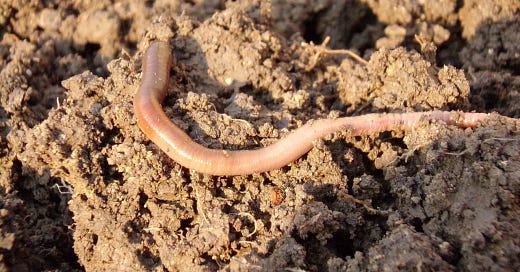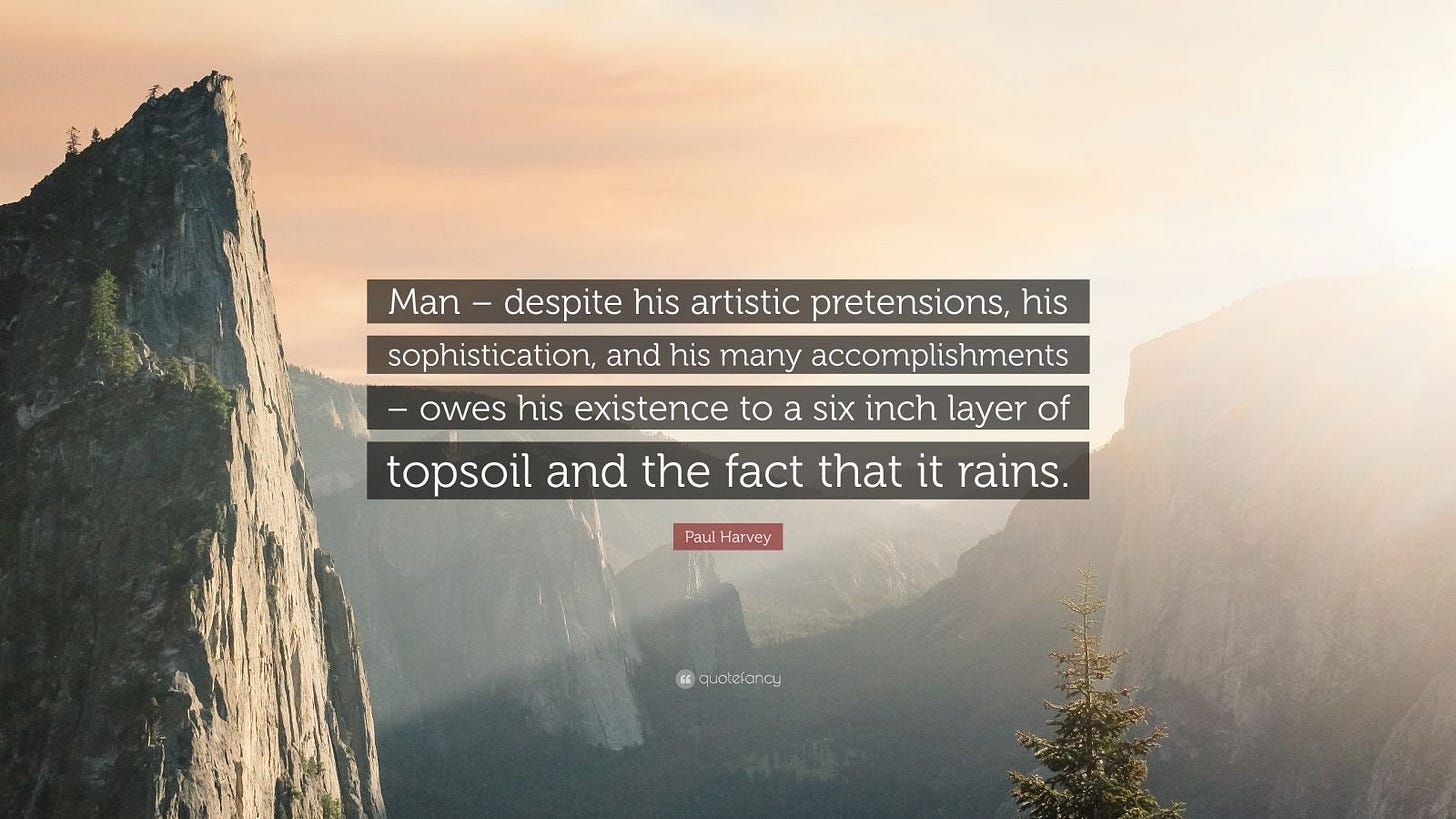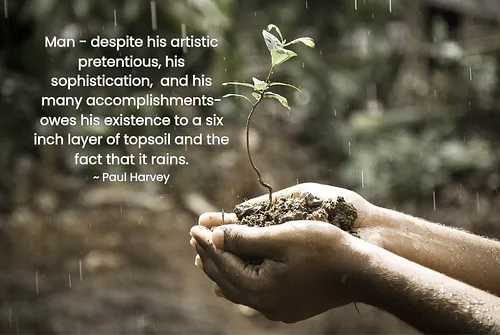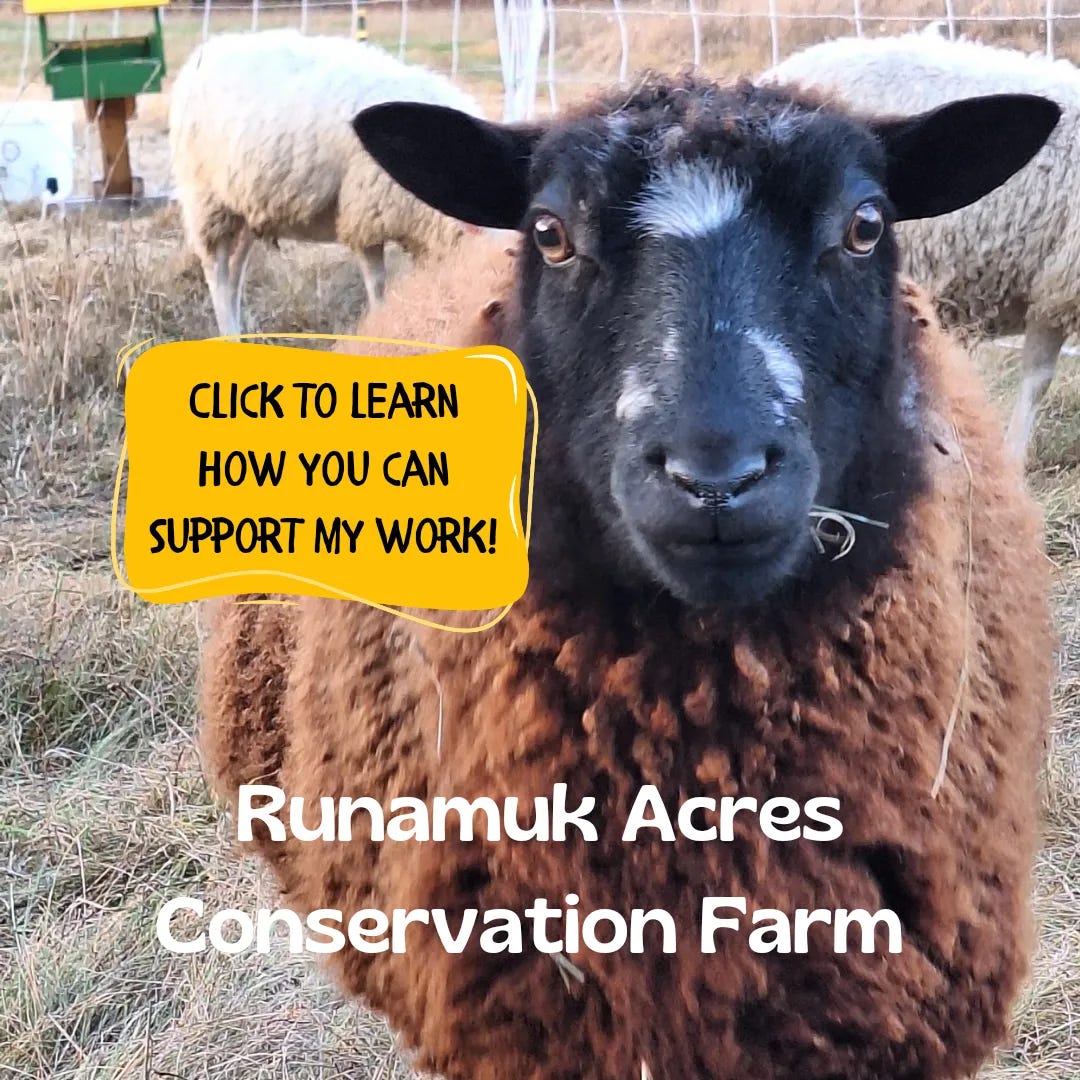Beyond Dirt: Transforming Our Mindset to Protect Soil Life and Beneficial Insects
Only when we change our mindset about "bugs"- can we hope to reduce the ongoing loss of biodiversity and topsoil we are experiencing on Earth...
The cricket song was deafening as I walked the length of the field, dogs roving ahead, snuffling their way across the pasture and back again. A thick cloud of flying insects hung suspended above the thatch of grasses, forbes and wildflowers and my heart swelled, tears pricking my eyes. While some might find the sight abhorrent—to this humble farmer it is a thing of beauty and I revel in it’s magnificence.
Welcome to the latest Updates From the Farm! If you are new here, I invite you to check out my About page to learn what this is, who I am and why I am doing this. Or just dive right in! At “Runamuk Acres” you’ll find the recantings of one lady-farmer and tree-hugging activist from the western mountains of Maine. #foodieswelcome
In This Article:
The Current Mindset Problem: “Bugs are Yucky”
The Littles: Nature’s Workforce
The Soil as a Living Ecosystem
Why Soil Life Matters
The Farm Ecosystem
The Biological Nature of Soil
Changing the Mindset
5 Actionable Steps for Farmers & Gardeners
5 Actionable Steps for Anyone
Beyond Dirt
It’s not hard to see the difference we’ve made at the Runamuk Acres Conservation Farm.
By employing rotational grazing with our flock of Finnsheep, we’ve taken our soil beyond dirt to protect and encourage soil life and other beneficial insects. As a farmer and conservationist, I’ve been able to feed the soil, stimulating plant-growth and improving the habitat for the entire community.
And in the words of Aldo Leopold, “the community includes the soil, water, fauna and flora—as well as the people.”
Where once the grasses were sparse and limited in species, now exists a healthy thatch of forbes with a diversity that increases annually. The field feeds not only our sheep, but numerous bird species, including bluebirds, wild turkeys, eagles and hawks. The local deer population frequents this sheltered pasture, and on occasion I catch sight of a sleek red fox on the prowl.
It’s ironic to think I was once just as disgusted and fearful of “bugs” as the next person. Yet, my journey into farming has brought about a transformation in my mindset. I’ve come to understand the inter-connectedness of life on our planet. These creatures are the basis for all life on Earth. Without bacteria and microbes, insects and fungi—life could not exist.
We truly owe our existence to a six-inch layer of topsoil.
And that, my friends, is why I’ve dedicated my life to the protection of soil-life and beneficial insects.
The Current Mindset Problem: “Bugs are Yucky”
Largely, the current mindset problem stems from the fact that most people don’t understand the service these organisms DO for the planet. We’ve developed a “bugs are yucky” mentality, perceiving insects as annoying and expendable.
“They don’t do anything. They’re just there.”
Can you believe that’s what they told Dr. Elaine Ingham back in 1978 when she told her professors that she wanted to study the organisms in the soil?
Humanity goes to great lengths to eradicate insects, fungi and microbial life.
Prioritizing immediate yields over long-term soil health, industrial agriculture employs broad-spectrum pesticides that kill not only pests, but beneficial insects like pollinators and natural predators.
Monocropping eliminates habitat diversity, leaving no refuge for insects and soil organisms, while synthetic fertilizers alter soil pH, depleting the organic matter that microbial life feed on.
Tillage practices and the use of heavy machinery destroys soil structure, disrupting habitat and killing organisms like earthworms and mycorrhizal fungi, critical for nutrient recycling.
These practices create a vicious cycle of ecological degradation, reducing the resilience and productivity of agricultural systems over time.
According to a survey taken by Chapman University, approximately 25% of the population reported being somewhat or very afraid of bugs. While, nearly 40 percent of all phobias are related to bugs, insects and spiders—including arachnophobia, the irrational fear of spiders.
I admit, I used to be of that same “bugs are yucky” mentality. It’s the legs, lol.
As chance would have it, however, my highschool sweetheart was fascinated by insects. He was forever bringing beetles for me to look at, pointing out butterflies and other creepy crawlies.
Over time, I began to develop an appreciation for insects—even if I did not want them in my personal space. The journey of my life brought me to homesteading and gardening, and almost by default I fell into beekeeping back in 2010.
That’s when I really became obsessed enamored with insects.
The Littles: Nature’s Workforce
Bees changed the course of my life entirely.
In the beekeeping clubs they call it “bee-fever”—and I had it bad.
While I’ve always loved animals, I was suddenly overcome by a sick fascination of these winged, stinging insects. As though my eyes had been opened to the wonders of a whole new world, I was mesmerized by what I saw and came to know bees as a keystone species, pledging myself to bee-friendly farming.
Yet, the more I learned, the more I realized it’s not just pollinators at work here. It goes deeper than that. Soil microbial life and mycorrhizal fungi are equally as important to an ecosystem as bees.
In fact, they play a vital role that has long been overlooked, discredited and discounted.
Forever the underdog myself, I’ve developed a new affinity for “the Littles”, as I call them. Modifying my mission from bee-friendly farming, to dedicate myself to the conservation of soil-life and beneficial insects—to include microbial life and fungi, as well.
The Soil as a Living Ecosystem
It wasn’t until 1986 that science established soil as a living ecosystem and that nutrient cycling is performed by the beneficial organisms in the soil.
According to Dr. Elaine Ingham, the world’s leading soil biologist, when she first entered the field wanting to know what these organisms DO for the soil, people told her it was a waste of time:
“[all of the professors] said these organisms do nothing for soil and plants. and I wondered, ‘What’s wrong with these people?’ ”
Dr. Ingham believed that nature doesn’t keep things that don’t serve a function, and so she persisted in her studies.
While the study of soil biology is still relatively young, we’ve learned since the 80’s that it is the microorganisms which facilitate all of the critically important things happening in soil. Without them we can’t hope to grow healthy plants.
Here’s how it works:
According to Dr. Ingham, all of the nutrients our plants need are already there in the dirt and rocks surrounding their roots, but in an insoluble form.
Plants need the mircoorganisms in the soil to ingest the inorganic nutrients to convert them into a soluable form which they can then extract the necessary nutrients and minerals from.
To encourage this process, plants convert sunlight into “exudates”—essentially a simple sugar—which is stored in and around the plant’s roots. These sugars are used to send a message to bacteria and fungi living in the soil of what the plant requires. Those bacteria and fungi then begin to pull the nutrients from the sand, rocks, clay etc., storing it in their bodies, converting it into an organic form inside the bacteria.
The bacteria and fungi is then eaten by predators: nematodes, protozoa and microarthropods—who then poop out all of the nutrients these microorganisms have stored in their bodies. Thus making the nutrients and minerals available to the plants in an organic form which is easily ingestible for them.
To learn more about the soil food web, I encourage you to watch Dr. Ingham’s video below, or check out the Soil Food Web School for more information.
Why Soil Life Matters
Not only does the soil microbial life help unlock nutrients, making them readily accessible to plants, these organisms offer a broad spectrum of services necessary to any ecosystem:
Soil microorganisms make nutrients available at the rates plants require.
They help plants retain nutrients, preventing soil leaching.
Good bacteria and mircobes protect their host-plants from the bad bacteria and viruses that cause disease.
Soil mircoorganisms suppress weeds by keeping nitrate levels low, while more fungi in the soil means fewer weeds can grow.
Promote carbon sequestration.
They even help to decompose toxins in the soil.
All of this happens because of the biology in our soil. Without soil all we have is dirt.
The Farm Ecosystem
In his book: “The Farm as Ecosystem”, Jerry Brunetti says,
“Far too many biological or organic farms are woefully “understaffed” with plant and animal diversity.” and: “are organic monocultures of corn, soybeans and alfalfa really worthy of boasts?”
In order to be whole, interconnected and dynamic soils must be impregnated with the biodiversity of nature. That biodiversity includes the innumerable species of microbes (bacteria, bacteriophages, viruses, fungi, protozoa, algae), the arthropods, miscellaneous insects, pollinators, even birds and mammals.
These biological components in turn depend on the biodiverse presence of hundreds of plant species in a local environment. The farm is an ecosystem like any other ecosystem.
The Biological Nature of Soil
In researching the growth patterns of bacterial colonies, scientists in Japan and Israel have discovered branching patterns of Bascillus subtilis can become increasingly sparse as the nutrient density became scarce—or as the gel medium it grew upon became harder.
Brunetti cites, the scientists discovered the changes to branching patterns were caused by cellular communication (chemotaxis). This means bacteria emit biochemicals acting as communication molecules to encourage microbes to move away from not-so-friendly environments.
In other words, the fractal complexity and density depend on the food availability and the friendliness of the environment.
The microbial biomass is the unseen ecology of our planet’s biology, even though microbial systems make up 50% of Earth’s total biomass and 80% of all Earth’s biodiversity is microbial.
Comprised of 10 trillion cells that compose our organs, tissues, etc. humans are made up of various microflora living in us and on us. Over 80% of these bacteria reside within the intestinal tract, where there’s literally 3-5 lbs of these symbiont probiotics, consisting of 500-1000 different species.
Unbelievably, less than 25% of these microbes have been identified.
Comparatively, soils contain an estimated 2-3 million species of bacteria, along with approximately 1.5 million species of fungi, and only 2-5% of these have been described or named.
How can we have robots searching for life on Mars, while we ignore and marginalize the most significant life forms that allows this planet to be alive?
Changing the Mindset
Only when we change our mindset about the Littles—about bugs and bacteria, fungi and microscopic arthropods—can we hope to reduce the ongoing loss of biodiversity and topsoil we are experiencing on Earth.
Your body is a walking, talking sack of microbes all working together to keep you alive and well for their own good as well as yours. Our bodies are like a honeybee colony, in that sense. Everyone working for the good of the whole.
Only when we work in tandem with the natural processes already in place can we hope to grow food that reaches it’s full nutritional potential.
What can you do about it, though…?
I hear ya, my friend.
I’m right there with you. Life is busy. Overwhelming. Stressful. What could you possibly do to affect such a big problem with your limited time and resources?
Well, I’m here to tell you that whether you’re just a backyard gardener, or even if you live in an apartment in the city, there’s something we can all do wherever we’re at right now to help protect soil-life and beneficial insects around you.
It all starts with recognition and respect. We need to recognize what these creatures bring to the table and respect them for it. From there, it just takes practice and consistency to change our mindset regarding “bugs”. You’ll be surprised how far the ripples you create will travel.
5 Actionable Steps for Farmers & Gardeners
Test and monitor your soil regularly: The local cooperative extension has text kits readily available for free. You would simply send it off to the University for analysis.
Reduce chemical inputs: Not only do they destroy soil life, chemical inputs can leach into waterways, affecting the entire ecosystem.
Practice rotational grazing: Regenerative methods of agriculture such as rotational grazing stimulates plant growth both above and below the soil, while also feeding the microbial life the plants depend on.
Implement cover crops: Incorporating cover crops not only prevents erosion, but serves to shelter and nourish the life-forms living within the soil. Clever use of cover crops can help growers to improve conditions for microbial life, thereby increasing the health of crops and the nutritional value of their harvest as a result.
Diversify your crops: Practice companion planting to diversify crops and create a more hospital environment for your natural allies (soil mircobes and beneficial insects, insect-eating birds etc.).
Recommended Reading FMI: Soil Health Principles and Practices via Farmers.gov.
5 Actionable Steps for Anyone
Recognize and respect bugs, and teach your kids to do the same: Learn more about insects and the role they serve in the environment. Get to know them, admire their colors and shapes. Sometimes local libraries or nature centers have an “Insect Appreciation Day” when children can come see different species and learn more about them. Above all, even if their many long legs gross you out, try to appreciate insects for the service they provide, and don’t kill them just for the sake of killing a bug. We all deserve to live our lives.
Reduce the use of harsh chemicals: If you are a home-owner, try to minimize harmful practices like the use of lawn chemicals. Statistics show that homeowners often use significantly more chemicals per acre on lawns and gardens compared to farmers. https://blog.nwf.org/2024/04/why-we-shouldnt-have-lawns/
Create bug-friendly spaces: Even apartment dwellers can create bug-friendly spaces on balconies and windowsills. While homeowners have the option to leave wild areas on their property, provide a water source and leave the leaves.
Sometimes doing less is the key to doing more.Buy organic or local food, and purchase eco-friendly products whenever possible: Opt for locally sourced produce and sustainably made goods to indirectly support insect-friendly practices. Be okay with “ugly” produce as this allows farmers to reduce their dependency on chemical pesticides.
Get involved: Volunteer your time and energy to support community initiatives like pollinator gardens, green roofs or habitat restoration. Educate and spread awareness by hosting a bug-friendly event—several years back I hosted a Firefly Festival, for example. Talk to building managers or neighbors about adding pollinator plants to common areas.
Recommended Reading FMI: Dr. Ingham’s Soil Food Web is a wealth of resources.
Beyond Dirt
Nearing the back of the field, where forest meets field and field meets forest, I met an intoxicating fragrance. Curiously I sought the source and found an autumn olive in full bloom, discovering that I was not the only one drawn by the allure of the plant’s perfume.
The shrub was teeming with pollinators.
Bumble bees and honeybees, sure—I kind of feel as though honeybees have become the superstars among pollinating insects. They’ve garnered a lot of recognition in the last decade or so, serving as spokesperson spokesinsect for their kind. Yet there are some 200,000 species of pollinating insects world wide, and I feel like the other 199,999 species aren’t receiving the appropriate level of respect and appreciation due them.
Don’t get me wrong—I still love opening a hive to work with my honeybees—but I’ve learned so much that I cannot discredit these other organisms or the service they provide.
Settling in to observe the going-ons, I kneeled on the ground and watched the bugs at work. Mostly, I have yet to learn the names of Maine’s 270 native pollinators, and to put a face with those names—though I have a handful I can identify.
It’s easy enough to discern a bumblebee from any other type of bee, and of course I can spot a honeybee even in a crowd. The sweat bees, though, are my favorite because of their vibrant coloring in metallic teal or turquoise.
Other insects feed on the nectar of flowers, too, and I watched the flies and wasps that shared the blossoms with the variety of bees. There was no fighting or aggression. Each animal, supremely focused on it’s own task, cared not for the concerns of others.
Watching a dance that has been ongoing for some 120 million years moves me. It’s beautiful and profound to think that so much of the diversity we have on Earth comes down to this simple action. The plants provide free food and the insects, in turn, provide the service of distributing pollen to ensure the plant’s reproductive future.
What a marvel.
And when we look at soil, at the microbial life that exists there these last 3.5 billion years, should we not feel that same sense of awe and gratitude?
I get it—they’re not so warm and cuddly-looking as a fuzzy little honeybee. In fact, unless you look under a microscope you can’t see microbes at all, so why should we care?
Yet, everything we are is made up of microbes.
Your body is a walking, talking sack of microbes all working together to keep you alive and well for their own good as well as yours. Our bodies are like a honeybee colony, in that sense. Everyone working for the good of the whole.
The life within our soils is every bit as essential as our pollinators to the functioning of Earth’s ecosystems—if not more so. That’s why I encourage you to look beyond “dirt” and begin the work of transforming your mindset to protect soil life and beneficial insects today.
Sending love and good juju to you and yours.
Your friendly neighborhood farmer,
Sam
Thank you for following along with the story of this lady-farmer! It is truly a privilege to live this life serving my family and community, and protecting wildlife through agricultural conservation. Check back soon for more updates from the farm, and be sure to follow @RunamukAcres on Instagram or Facebook!










You are speaking my language with this essay! Brilliantly done, thank you. I wish more people recognized the microbes hard at work all around (and inside) us.
On my own little mini-farm I've seen a tremendous shift in critter activity as I slowly restore native plants, reduce tillage, and use more cover crops at various times of the year. It's quite a thing to just sit quietly in the garden and listen to the sounds of the bees and insects buzzing and finding nectar well into the last weeks of autumn. Each year feels like an opportunity to learn more about them. I can't wait to see what they teach me next.
Many thanks to you Sam for your inspiring leadership on the need for a major shift in our food production paradigm. Your writing here on Substack, and your real-world impact through your farming and conservation work, all matter greatly. I recognize and applaud all your efforts and sacrifices for that vital cause! 👏🌱